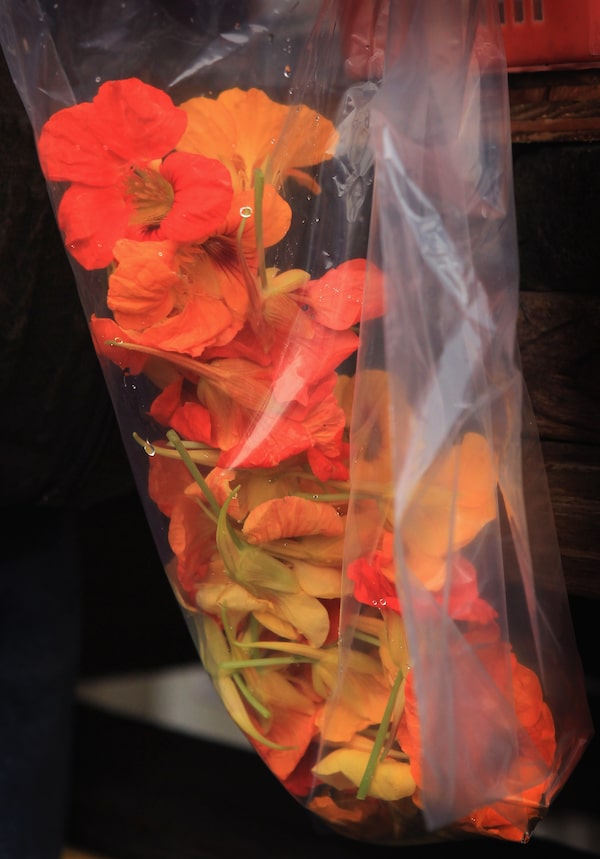In gardening, I am motivated, as with most things in life, by gastronomic potential. But I am also a craven philocalist, and the idea of combining new flavours and textures with unexpected colour and beauty to my home cooking intrigues me. So I took inspiration from a recent trip to Maui, where my every spinach salad and mai tai was adorned with frangipani (plumeria) flowers when planning my container garden this year.
I decided I wanted three things simultaneously: a decorative array to brighten the terrace, edible flowers I could use as informally as I do fresh herbs (not as culinary novelties but as commonplace ingredients) and an attraction for pollinators to my little patch of concrete in the city.
Summer recipes: Fresh from the garden or market to your table
My curiosity about edible flowers started a few years ago, after chef Justin Cournoyer, owner of acclaimed restaurant Actinolite, which is in my Toronto neighbourhood, knocked on my door for permission to do some urban foraging. I peered into my front yard, wondering what had possibly piqued his culinary imagination. Turns out the lone tree in my yard is a Japanese lilac: In early summer, the creamy white flowers sweetly perfume the air, but the blossoms can apparently be dried and used as tea (the taste is similar to elderberry), among other things.
This summer, the Japanese lilac was in full bloom in June as I waited for my edible flower plantings to get going, so I steeped a few cups of the fluffy clouds of florets in honey syrup. I found it also makes a nice cake glaze and is a good base for both a gin spritz and a refreshing teetotal soda. At the same time, I took a closer look at the lilies bordering my driveway – aggressively spreading like an invasive weed, more accurately. But after I ascertained that the encroaching orange flowers were not toxic tiger lilies but edible day lilies, I started raiding that patch, too. Withered day lilies aren’t much to look at, but it’s another story once those spent orange blooms are sautéed, stuffed with bread crumbs and lemon zest, the way you would zucchini blossom, or chopped into potato salad.
I’m not (too) embarrassed to admit how I planned my edible garden. Some floral choices were inspired by the idea of feasting with fiction – specifically Dinner with Mr. Darcy’s authentic period recipes taken from Jane Austen’s novels and letters. Growing up, the Austens cultivated two walled gardens of medicinal and culinary plants and flowers, including borage and marigold. Pot marigold, or calendula, has petals with a lovely sharp bitter taste (similar to saffron) that rounds out orange cake, is striking when scattered across the cream of a Victoria sponge or an Ottolenghi dish, and is earthy when folded into soups. Like saffron, the petals also tint goat cheese and rice the colour of a Maxfield Parrish sunset. Likewise, the tender leaves and vibrant red, orange and yellow flowers of nasturtium have a peppery tang, like watercress, that add zing to pizza, pasta and green salads.

Nasturtium flowers harvested are packaged for delivery on Sept. 30, 2011 in Chicago. The flowers' leaves have a peppery tang, like watercress, that add zing to pizza, pasta and green salads.Scott Olson/Getty Images
Now midsummer, the garden is flourishing and I’ve settled into a rhythm, though I do struggle to keep up with the output. After the morning gathering, the nasturtium and borage multiply again by dusk. Even with storing fresh culinary flowers in glass-lidded jars, I still have to give them away by the handful.
The arts and craft aspect of having a few little projects to do with culinary flowers also appealed to me. Initially, anyway. In a burst of industriousness after one of my first harvests, for example, I set about trying to candy a few dozen pansies. Armed with bowls of egg whites, superfine sugar and tweezers, it was tedious, fussy work – and antithetical to both my style as a home cook and to the easygoing summer mood. Likewise, with my attempt to suspend violets in ice cubes. The process is overly complicated for the result, because it requires distilled water and several stages of gradual freezing. Nope.
Instead, I mixed colourful petals into ricotta, cream cheese or chèvre and spread it on crostini to give cheese-on-toast a sense of occasion. A tomato tartine slathered in Vegenaise was heaped with tart, citrusy sorrel leaves and flowers, a jewel-toned beet and citrus salad studded with borage’s periwinkle-blue stars, which have a cucumber taste. Soon, the lavender buds will sprout and be used to season meat, like I do with rosemary, or infuse homemade ice cream. My purple and white pansies flecked with yellow have a lightly minty, cut-grass flavour for a herbaceous addition to a cocktail or stirred in with fresh peas and on grilled asparagus, or dotting a rustic apricot tart.
Thinking ahead, I infused sugar with cuttings from a neighbour’s purple lilac, for dusting on scones and flavouring crème fraîche. When I’m well info fall and winter, it will be a fragrant reminder of lilac’s pungent, slightly soapy scent and its promise of spring. In the meantime, on summer nights I walk around the neighbourhood and spot edible riches everywhere. I wonder, do people whose flower beds overflow with pretty nasturtium realize what they’re missing at dinnertime?
Live your best. We have a daily Life & Arts newsletter, providing you with our latest stories on health, travel, food and culture. Sign up today.